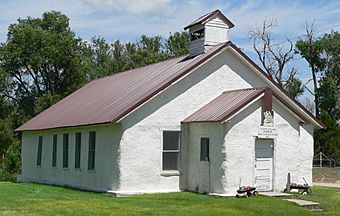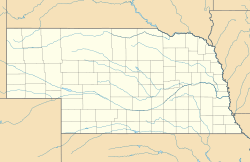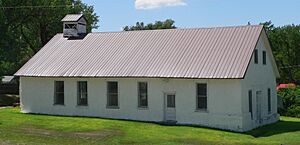Pilgrim Holiness Church (Arthur, Nebraska) facts for kids
Quick facts for kids |
|
|
Pilgrim Holiness Church
|
|

View from the southwest
|
|
| Location | Northwest corner of Cedar and Heath Streets, Arthur, Nebraska |
|---|---|
| Built | 1928 |
| NRHP reference No. | 79001434 |
| Added to NRHP | June 18, 1979 |
The Pilgrim Holiness Church, also known as the Baled Hay Church or the Baled Straw Church, is a special church built in 1928 in Arthur, Nebraska. It's unique because it was made from baled rye straw. At that time and place, regular building materials were very expensive or hard to find. This church is listed on the National Register of Historic Places because of its unusual way of being built and its connection to the history of people settling the Nebraska Sandhills.
Contents
Building with Baled Straw
Imagine building a house out of giant hay bales! That's how the Pilgrim Holiness Church was made. Early settlers in the Nebraska prairies found very few trees. This meant they had to find other ways to build homes and other buildings. In some parts of Nebraska, people used soil to build dugouts (underground homes) or sod houses (houses made of grass and dirt blocks).
However, in the Sandhills, the soil was too sandy to make good sod blocks. Also, there were no railroad lines reaching Arthur County. This made it very expensive and difficult to bring in wood or bricks from other places.
How Straw Bales Became a Building Material
The machine that bales hay was invented in the 1850s. By the 1890s, it was widely used. The first time hay bales were used for building in Nebraska was for a schoolhouse around 1896 or 1897. But that schoolhouse didn't have any plaster or stucco to protect it. A report from 1902 said that cows had eaten parts of it!
Even with that funny story, building with straw bales became popular. Between 1896 and 1945, about 70 buildings were made from straw bales in the Sandhills. These included houses, farm buildings, churches, schools, and even grocery stores. By 1990, nine of these bale buildings were still standing in Arthur and Logan Counties.
The Pilgrim Holiness Church Story
In 1927, a group of people from the Congregational Church in Arthur decided they wanted to build a church. They started building it the next year, in 1928. The church was constructed using stacked bales of hay. Its walls are very thick, about 2 feet (60 centimeters) wide!
Today, the outside of the church is covered with stucco, and the inside has plaster. But during some repairs in 1976, people discovered that it was originally plastered on both sides with a special "gumbo mud" found nearby.
The Pilgrim Holiness Church is very important because it's the oldest known straw-bale church in all of North America. There are only two other known straw-bale churches that still exist today. One was built in 1954 near Sexsmith, Alberta, Canada. The other, St. Francis in the Redwoods, was built in 2007 in Willits, California.
Regular church services are not held there anymore. The Arthur County Historical Society now owns and takes care of the church. It was added to the National Register of Historic Places in 1979, recognizing its special history and unique construction.
Settling Arthur County
Arthur County is located in a unique area called the Nebraska Sandhills. This region has sand dunes that are covered and held in place by grass. Rain easily soaks into the sandy soil, which fills up the underground water supply. This creates hundreds of permanent lakes in the area.
However, the sandy soil isn't very good for growing crops. So, the Sandhills are mostly used for raising cattle.
How People Claimed Land
Much of eastern Nebraska was settled because of the 1862 Homestead Act. This law allowed settlers to get a piece of government land, about 160 acres (65 hectares), for a small fee. But in the Sandhills, 160 acres wasn't enough land to support a family. So, ranchers often claimed large areas of federal land and used the homestead laws to secure lakes and streams for their cattle.
Later, the 1904 Kinkaid Act allowed homesteaders in 37 western Nebraska counties to claim a much larger piece of land: a full section, which is 640 acres (260 hectares). This, along with the opening of a forest reserve in 1911, caused the population in what is now Arthur County to grow very quickly.
Arthur County was officially created by the Nebraska government in 1912-1913. The town of Arthur was chosen as the county seat (the main town) in 1913. By 1920, the county had a population of 1,412 people, which was a big jump from just 91 people in the area in 1890.




